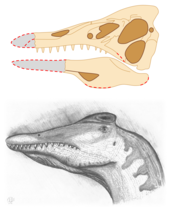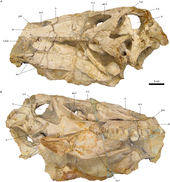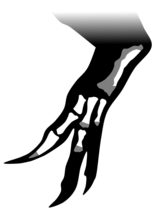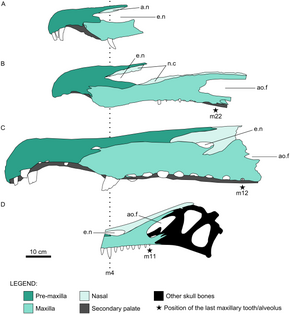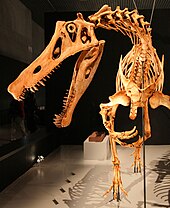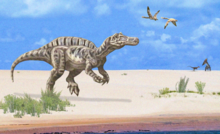Irritator
Other spinosaurid skeletal material, some of which could belong to Irritator or Angaturama, was retrieved from the Romualdo Formation, allowing for a replica skeleton to be made and mounted for display at the National Museum of Rio de Janeiro in 2009.
[1] The skull (designated SMNS 58022) became the holotype specimen of the new genus and species Irritator challengeri in February 1996, when it was first scientifically described by paleontologists David M. Martill, Arthur R.I. Cruickshank, Eberhard Frey, Philip G. Small and Maria Clarke.
Under the supervision of American paleontologist Hans-Dieter Sues, technician Diane M. Scott from the University of Toronto at Mississauga assumed the task of fully extracting the skull bones from the rock, allowing for a detailed redescription in 2002.
As in the previous study, Sues and colleagues regarded the African and possibly South American [11] genus Spinosaurus as the most similar taxon to Irritator, because they shared many dental features, including mostly straight conical tooth crowns, thin enamel, well-defined edges with no serrations, and lengthwise fluting.
[1][12] Angaturama limai, another spinosaurid from the same time and place as Irritator challengeri, was described by the Brazilian paleontologists Alexander W. A. Kellner and Diogenes de Almeida Campos in February 1996.
[15] In 1997, British paleontologists Alan J. Charig and Angela C. Milner considered Angaturama a likely junior synonym of Irritator, noting that both genera had retracted nostrils, long jaws, and characteristic spinosaurid dentition.
Sales and Schultz also identified a possible point of overlap, the third left maxillary tooth, and observed that the skull of Angaturama could have been larger than that of Irritator based on the proportions of the closely related genus Baryonyx.
[23] Besides the skull, the snout fragment, and some isolated teeth, the Romualdo Formation has also yielded postcranial remains that may belong to spinosaurids, many of which are hitherto undescribed, and all of them pertaining to the Spinosaurinae subfamily.
[7] Only the rear ends of the paired premaxillae (frontmost snout bones) remain intact, forming the front upper and lower borders of the external nares (bony nostrils).
[7] Although the complete shape and height of this structure is unknown in Irritator, these head crests were commonplace in spinosaurids, having possibly served a display function when the animal was alive.
[7][41] Also like its relatives, Irritator had two additional openings on the skull roof (called the postnasal fenestrae) as well as long and only partially diverging basipterygoid processes (bony extensions connecting the braincase with the palate).
[22][40] MN 4819-V is distinguished from Suchomimus due to its longer and shallower ilium with a less curved upper margin,[2][26] and from Baryonyx by having a more developed obturator process, a blade-like structure on the bottom of the ischium.
[26] Martill and his team originally classified Irritator as a maniraptoran dinosaur in the clade Bullatosauria (a group no longer considered monophyletic[43]), as a close relative to the feathered[44][45] ornithomimosaurs and troodontids.
[1] Some of these claims were questioned in 1996 by Kellner who found that Irritator's skull lacked the one autapomorphy (distinguishing feature) diagnosed in maniraptorans at the time, which was having its jugal (cheek) bone forming part of the antorbital fenestra.
Sales and Schultz thus noted that the Araripe Basin spinosaurids Irritator and Angaturama might represent intermediate forms between the earlier baryonychines and later spinosaurines, and that further research may eventually render the former a paraphyletic (unnatural) group.
[12] Although Angaturama limai's snout is generally narrower than in other spinosaurids, this might be due to damage sustained by the fossil; the holotype appears partly crushed and broken on its lower margin, with some of the preserved teeth having been sectioned off along their length.
In 2007, a finite-element analysis study by British paleontologist Emily J. Rayfield and colleagues found that these attributes, present in other spinosaurids as well, made the skull more resistant to torsion from prey item loads when feeding.
[7][53] The nostrils of Irritator were shifted far back from the snout tip; this, along with the secondary palate, which separated the animal's nasal passages from the inside of its mouth, made respiration possible even if most of the jaw was underwater or held prey.
[54] Sales and Schultz in 2017 found that Irritator and baryonychines might have relied more on their sense of smell for hunting than Spinosaurus did, since they had larger, less retracted nostrils and more room in their skulls for the nasal cavity.
[7] Naish and colleagues in 2004 supported the theory that Irritator hunted both aquatic and terrestrial animals as a generalist within the coastal area and in addition probably searched for carrion.
[24] Examinations and digital reconstructions of Irritator published in 2023 by Schade, Rauhut et al., suggests that the lower jaws of this spinosaurid could rotate and open laterally, with a gape similar to that of modern pelicans; this would have allowed the theropod to swallow very large prey items.
It has been found that they probably took advantage of aquatic prey and environments (usually marginal and coastal habitats[58]) to occupy a distinct ecological niche, therefore avoiding competition with more terrestrial theropods.
They found that the frontal bones of Irritator, Spinosaurus, and Sigilmassasaurus were similar in being arched, concave on top, and narrowed at the front; features that would have resulted in the eyes being positioned further up on the head than in other theropods.
[64] In 2020, German paleontologist Marco Schade and colleagues analyzed the anatomy of the holotype skull braincase through CT scans, revealing numerous details about behavioral capabilities of Irritator.
With the scans, they created a 3D model of the skull and braincase, discovering that Irritator had elongated olfactory tracts and a relatively large floccular recesses (area that pierces through the semicircular canals and connects the brain with the inner ear).
[69] This environment was dominated by pterosaurs, including: Anhanguera, Araripedactylus, Araripesaurus, Brasileodactylus, Cearadactylus, Coloborhynchus, Santanadactylus, Tapejara, Thalassodromeus, Tupuxuara,[70] Barbosania, Maaradactylus,[71] Tropeognathus, and Unwindia.
[79] Various well-preserved fish fossils record the presence of: hybodont sharks, guitarfish, gars, amiids, ophiopsids, oshuniids, pycnodontids, aspidorhynchids, cladocyclids, bonefishes, chanids, mawsoniids and some uncertain forms.
[2] Sereno and colleagues postulated that divergent evolution between spinosaurines in South America and Africa likely occurred as a consequence of the Atlantic Ocean, whose opening gradually separated the continents and contributed to differences between taxa.
[7] Naish and colleagues in 2004 asserted that the Romualdo Formation dinosaur fauna is represented by animals that died near shorelines or rivers before being carried out to sea, where their floating remains were eventually fossilized.
[43] In 2018, Aureliano and colleagues argued against this scenario, stating that the Irritator challengeri holotype's mandible was preserved in articulation with the rest of the skull, whereas it would have likely detached had the carcass been floating at sea.

